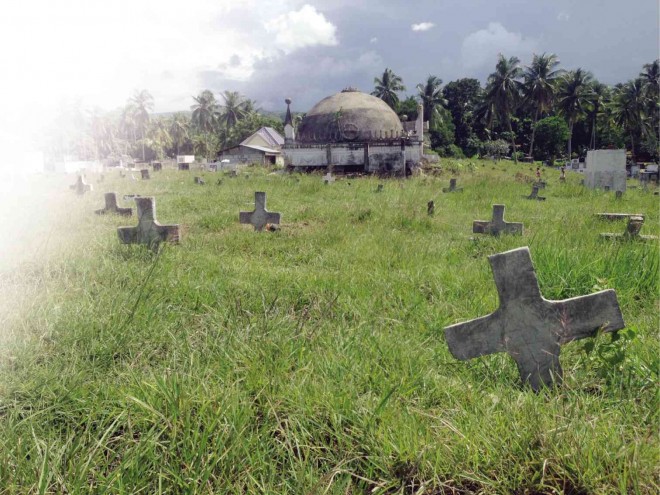
WHAT remains of the mausoleum of the Lufranco clan at Calape Catholic Cemetery is the dome that now covers the six tombs there.
CALAPE, Bohol—Every year, Roberto Guisihan would light three candles on a slab of cemented rock placed on the tombs of his great grandparents at the Catholic cemetery in Calape town, Bohol province.
He makes sure he pays his respects to his relatives, who died in the 1970s, though he lives 50 kilometers away in Barangay Calatrava in Carmen town. He believes that they would not visit him instead, especially since he had gone wayward when he was younger.
This time, however, Guisihan, 58, cannot help but feel sad seeing what has remained of the graves of Julian and Ignacia Guisihan at the cemetery, at least 39 km from the capital city of Tagbilaran. The tombs collapsed when a 7.2-magnitude earthquake shook Bohol on Oct. 15, 2013, and left 211 dead and 95,000 families homeless.
Several cemeteries on the island-province were destroyed, along with 20 municipal and city halls, two bridges, one hospital and other infrastructure facilities.
The Commission for Cemeteries of the Diocese of Tagbilaran does not have the exact number of cemeteries affected by the earthquake. But its chair, Fr. Julian Lupot Jr., said the hilltop cemetery in Antequera town suffered the heaviest damage.
At least seven tombs, mostly privately owned, were destroyed there, Lupot said, citing a report from the Antequera parish.
In other towns, some tombs had cracks, he said.
Worst-hit town
He cited the case of the public cemetery in the worst-hit town of Loon, where corpses could be seen and smelled in some tombs. Days before All Saints’ Day last year, parish personnel transferred the corpses to a new grave while the cemetery was being rehabilitated.
“We asked the families to have these transferred because these posed a health risk,” Lupot said.
Among the tombs still awaiting reconstruction a year after the quake are those of Guisihan’s great grandparents. Some 100 graves were destroyed or damaged during the quake at the Calape cemetery managed by the local parish, according to its caretaker, Loloy Cabalang.
The bones of his ancestors are still beneath the ruins, Guisihan said. He has yet to consult his cousins on whether the remains will be moved to the bone chamber or the tombs will be repaired.
“We don’t have money for the reconstruction. But it would be better to repair the tombs,” he said.
Lack of funds
Lack of funds was the main reason other tombs had not been repaired.
Most of the structures destroyed were already old while those managed by the church suffered cracks, said Fr. Aurelio Luzon Jr., Calape parish priest. He said it took more than a year for the cracks to be repaired, citing inadequate funds.
In Maribojoc town, the Catholic cemetery was badly damaged. But Fr. Warren Abarquez of Holy Cross Parish said the tombs had already been repaired, an indication that the town had slowly moved on.
The earthquake killed 18 people, destroyed 1,033 houses and damaged 1,923 others in Maribojoc. It flattened Holy Cross Parish, which had been declared a national heritage site.
When the Inquirer visited the Catholic cemetery on Oct. 25, the tombs had been painted white while the chapel at the center and the surrounding fence had been repaired. A year ago, the structures had either collapsed or had cracks.
While some tombs still need to be repaired, Father Luzon said he expected a number of families to still flock to the Calape cemetery on All Saints’ Day.
“This is where families could gather and children are taught to keep this tradition. When their parents die, it would be their turn to visit and remember them. It will also teach them that life must go on even if another one ends,” he said.